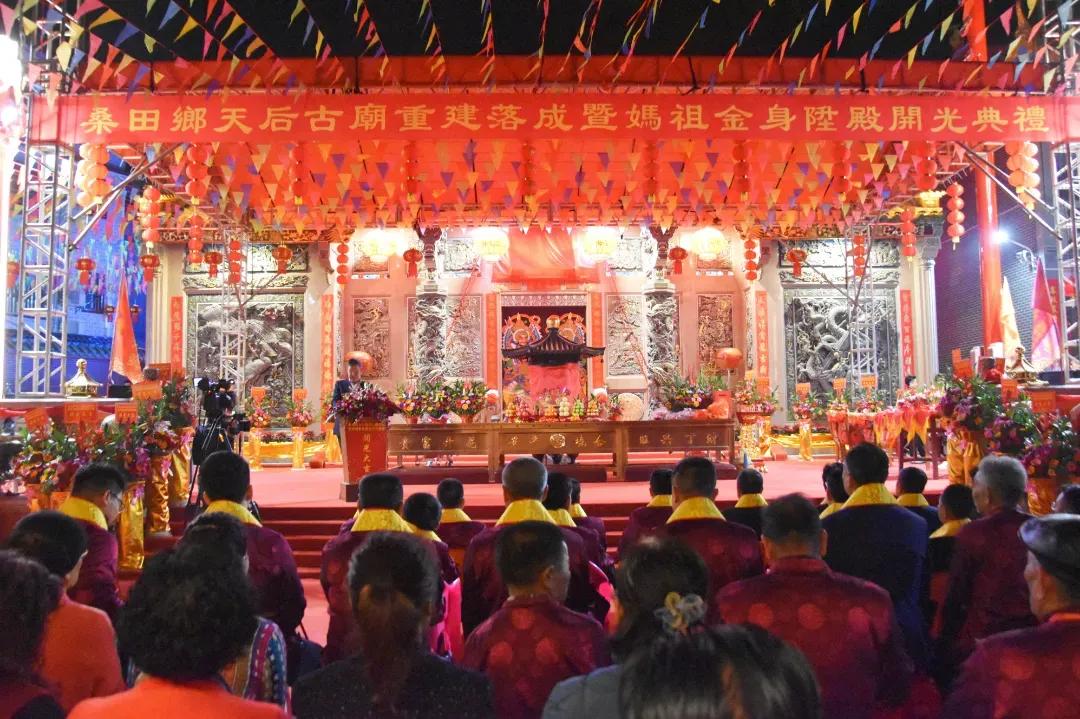
At 11:00 p.m., the opening ceremony officially began. At the event site, folk performances such as drum teams and lion dances brought an audiovisual feast with great Chaoyang cultural characteristics to the audience, and the atmosphere was festive and lively. Subsequently, the unveiling ceremony, the three-way gift ceremony, and the chanting of prayers and blessings were also held at the scene.
At auspicious o'clock in the early morning of the next day, the Mazu Temple Recitation Group of Meizhou and more than 100 people from the Sangtian Tianhou Ancient Temple in Hexi Town, Chaoyang District, Shantou City, Guangdong Province, held a prayer and blessing ceremony in the Sangtian Tianhou Ancient Temple.
Lin Fending, chairman of Sangtian Tianhou Ancient Temple, said: Sangtian is located at the mouth of the RongJiang River, has a natural fishing port, the ancestors to seek the sea for a living, before going to sea to worship Mazu, pray for blessings. As a result, Mazu became the patron saint of the Kuwata people. The ancient temple of Sangtian Tianhou is said to have been built in the Southern Song Dynasty, and has been built several times throughout the dynasties. Now, the Tianhou Ancient Temple has been rebuilt again, magnificent old system, carved beams and paintings, and overflowing with color and light. The inauguration ceremony is a great joy for the people of Sangtian and a major event in the construction and inheritance of Mazu culture in the construction and inheritance of Sangtian folk culture. I hope that the colleagues of the council will carefully protect and spread good relations, so that the Mazu god can carry forward and benefit all sentient beings!
Zhuang Meihua, vice chairman of the board of directors of Meizhou Mazu Temple, said: Chaoyang, with a long history and diverse cultures, is a famous historical and cultural city at home and abroad, and is one of the important areas of Mazu faith. The Mazu culture here has a long history, the Mazu faith is deep, and the Mazu culture has a wide influence on the development of Chaoyang. The reconstruction of The Ancient Temple of Sangtian Tianhou is due to the unremitting efforts of colleagues and Mazu believers, which will surely promote the comprehensive development of Mazu culture and local economy and culture, and benefit the people. We look forward to the future of your palace and Meizhou Mazu Temple more friendship, more exchanges, more closeness, work together to spread Mazu culture, carry forward the Mazu spirit, tell the story of Mazu and make greater contributions to further excavating, inheriting and protecting Mazu culture!
From November 1 to 10, 2017, a group of 200 people escorted Meizhou Mazu Temple Escort Group to escort The gods such as Meizhou Mazu, Clairvoyance and Shunfeng Ear to carry out a 10-day cultural exchange activity of "Meizhou Mazu Patrol an An Chaoshan" in Chaoshan, the political, economic and cultural center of eastern Guangdong. Mazu has stationed and stationed more than 10 Mazu cultural institutions, with a total journey of more than 1,000 kilometers, receiving nearly 5 million worshippers, setting off a wave of Mazu pilgrimage in Guangdong.